Mechanical Characterization and Constitutive Modeling of Nano-Stabilized Soil under Uniaxial Compression
Abstract
:1. Introduction
2. Materials and Methods
2.1. Nano-Stabilized Soil
2.2. Sample Preparation
2.3. Uniaxial Compression Test
3. Results and Discussions
3.1. Strength Variation of Uniaxial Compression
3.2. Uniaxial Compression Test Results
3.3. Constitutive Modeling of Uniaxial Compression
3.3.1. Equation Deduction of Constitutive Model
3.3.2. Parametric Analysis of Constitutive Model
3.3.3. Experimental Verification of Constitutive Model
4. Conclusions
Author Contributions
Funding
Institutional Review Board Statement
Informed Consent Statement
Data Availability Statement
Acknowledgments
Conflicts of Interest
References
- Stefanidou, M.; Papayianni, I. Influence of nano-SiO2 on the Portland cement pastes. Compos. Part B Eng. 2012, 43, 2706–2710. [Google Scholar] [CrossRef]
- Lavergne, F.; Belhadi, R.; Carriat, J.; Ben Fraj, A. Effect of nano-silica particles on the hydration, the rheology and the strength development of a blended cement paste. Cement Concr. Compos. 2019, 95, 42–55. [Google Scholar] [CrossRef]
- Zhang, X.C.; Gao, J.E.; Fan, H.H.; Li, X.H.; Gao, Z.; Xue, L.; Sun, S.L. Study on the Mechanism of Nano-SiO2 for Improving the Properties of Cement-Based Soil Stabilizer. Nanomaterials 2020, 10, 405. [Google Scholar] [CrossRef]
- Haeri, S.M.; Valishzadeh, A. Evaluation of Using Different Nanomaterials to Stabilize the Collapsible Loessial Soil. Int. J. Civil Eng. 2021, 19, 583–594. [Google Scholar] [CrossRef]
- Luo, L.; Wang, X.; Xue, C.; Wang, D.; Lian, B. Laboratory Experiments and Numerical Simulation Study of Composite-Material-Modified Loess Improving High-Speed Railway Subgrade. Polymers 2022, 14, 3215. [Google Scholar] [CrossRef]
- Zhang, J.; Ge, Y.; Yuan, G.; Song, Z. Consideration of high-quality development strategies for soil and water conservation on the loess plateau. Sci. Rep. 2022, 12, 8336. [Google Scholar] [CrossRef]
- Liu, Y.S.; Xia, J.; Wang, Y.S.; Song, J.X.; Zhao, X.Z.; Liu, X.Q. Coordinated human-earth system and high-quality development in Yellow River Basin. J. Northwest Univ. 2022, 52, 357–370. [Google Scholar] [CrossRef]
- Mahedi, M.; Cetin, B.; White, D.J. Cement, Lime, and Fly Ashes in Stabilizing Expansive Soils: Performance Evaluation and Comparison. J. Mater. Civil Eng. 2020, 32. [Google Scholar] [CrossRef]
- Ahmadi, H.; Shafiee, O. Experimental comparative study on the performance of nano-SiO2 and microsilica in stabilization of clay. Eur. Phys. J. Plus 2019, 134. [Google Scholar] [CrossRef]
- Yang, F.; Liu, X.; Wang, P.; Wang, S.; Robinson, I.; Chen, B. Investigation of spatial nano-structure development of the hardened C3S pastes by serial block-face SEM. Mater. Charact. 2021, 174, 110973. [Google Scholar] [CrossRef]
- Rostami, M.R.; Abbassi-Sourki, F.; Bouhendi, H. Synergistic effect of branched polymer/nano silica on the microstructures of cement paste and their rheological behaviors. Constr. Build. Mater. 2019, 201, 159–170. [Google Scholar] [CrossRef]
- Choobbasti, A.J.; Kutanaei, S.S. Microstructure characteristics of cement-stabilized sandy soil using nanosilica. J. Rock Mech. Geotech. Eng. 2017, 9, 981–988. [Google Scholar] [CrossRef]
- Mohammadi, M.; Khodaparast, M.; Rajabi, A.M. Effect of nano calcium carbonate (nano CaCO3) on the strength and consolidation properties of clayey sand soil. Road Mater. Pavement Des. 2022, 23, 2394–2415. [Google Scholar] [CrossRef]
- Xiao, J.Z.; Li, B.; Zhang, K.J.; Su, Y.W.; Pan, Y.B. Dynamic Mechanical Properties of Nano-Silica Modified Recycled Aggregate Concrete under Uniaxial Compression. J. Tongji Univ. (Nat. Sci.) 2021, 49, 30–39. [Google Scholar]
- Tan, Y.; Gu, Q.; Ning, J.; Liu, X.; Jia, Z.; Huang, D. Uniaxial Compression Behavior of Cement Mortar and Its Damage-Constitutive Model Based on Energy Theory. Materials 2019, 12, 1309. [Google Scholar] [CrossRef]
- Zhuo, J.; Zhan, Y.; Ma, M.; Zhang, Y.; Zheng, Y. Uniaxial Compression Failure and Size Effect of Recycled Aggregate Concrete Based on Meso-Simulation Analysis. Materials 2022, 15, 5710. [Google Scholar] [CrossRef]
- Takayuki, S.; Masaki, N. Attempt to reproduce the mechanical behavior of cement-treated soil using elasto-plastic model considering soil skeleton structure. Soils Found. 2021, 61, 1464–1474. [Google Scholar]
- Luis, D.J.; Manuel, C.; Ramón, M.J.; Francisco, A.; Julia, R. Feasibility of Using Nanosilanes in a New Hybrid Stabilised Soil Solution in Rural and Low-Volume Roads. Appl. Sci. 2021, 11, 9780. [Google Scholar]
- Kulkarni, P.P.; Mandal, J.N. Strength evaluation of soil stabilized with nano silica- cement mixes as road construction material. Constr. Build. Mater. 2022, 314, 125363. [Google Scholar] [CrossRef]
- Musa, M.M.E.; Xiong, X.; Zhang, Y. Experiment and Validation of Local Bearing Capacity for Ultra-High-Performance Concrete Confined with Stirrups. Materials 2022, 15, 5869. [Google Scholar] [CrossRef]
- Zhang, X.C.; Gao, J.E.; Fan, H.H.; Li, X.H.; Gao, Z.; Guo, Z.H.; Long, S.B.; Xue, L. Experimental Research on Mechanical Properties of Reconsolidated Loessial Soil with Nano Soil-Stabilizer. Res. Soil Water Conserv. 2021, 28, 131–137 + 143. [Google Scholar] [CrossRef]
- Di, D.; Jie, P.; Lanlan, B.; Gang, L.; Hongmin, L. The Effect of Superabsorbent Polymer on the Resilient and Plastic Strain Behavior of Cemented Soil under Traffic Load. Polymers 2022, 14, 929. [Google Scholar] [CrossRef]
- Man, D.; Pang, W.T.; Fan, Z.C.; Pang, W.T. Research on the Stress-strain Constitutive Model of Composite Cement Soil. Bull. Chin. Ceram. Soc. 2019, 38, 99–102. [Google Scholar]
- Guo, L.; Guo, X.; Hong, J.; Wang, Y. Constitutive relation of concrete containing meso-structural characteristics. Results Phys. 2017, 7, 1155–1160. [Google Scholar] [CrossRef]
- Fan, H.H.; Gao, J.E.; Wu, P.T.; Lou, Z.K. Analysis of influence factors for solidified soil strength based on change of physicochemical properties of loess. Rock Soil Mech. 2011, 32, 1996–2000. [Google Scholar]
- GB 50010-2010; Code for Design of Concrete Structures. China Architecture & Building Press: Beijng, China, 2010; 439p:A434.
- Gao, J.E.; Sun, S.L.; Wu, P.T. A New Type of Soil Stabilizer. CN Patent ZL 200410073273.5, 29 June 2005. [Google Scholar]
- Gao, J.E.; Zhang, X.C.; Gao, Z.; Sun, S.L. A Nano Soil Stabilizer and the Preparation Method. CN Patent CN 109294589A, 1 February 2019. [Google Scholar]
- JTG E51-2009; Test Methods of Materials Stabilized with Inorganic Binders for Highway Engineering. China Communications Press: Beijing, China, 2009; 171p;A174.
- Thomas, G.; Rangaswamy, K. Strengthening of cement blended soft clay with nano-silica particles. Géoméch. Eng. 2020, 20, 505–516. [Google Scholar] [CrossRef]
- Peng, Y.; Ma, K.; Long, G.; Xie, Y. Influence of Nano-SiO2, Nano-CaCO3 and Nano-Al2O3 on Rheological Properties of Cement-Fly Ash Paste. Materials 2019, 12, 2598. [Google Scholar] [CrossRef] [PubMed]
- Khaloo, A.; Mobini, M.H.; Hosseini, P. Influence of different types of nano-SiO2 particles on properties of high-performance concrete. Constr. Build. Mater. 2016, 113, 188–201. [Google Scholar] [CrossRef]
- Sun, J.; Shen, X.; Tan, G.; Tanner, J.E. Modification Effects of Nano-SiO2 on Early Compressive Strength and Hydration Characteristics of High-Volume Fly Ash Concrete. J. Mater. Civil Eng. 2019, 31. [Google Scholar] [CrossRef]
- Thangapandi, K.; Anuradha, R.; Archana, N.; Muthuraman, P.; Awoyera Paul, O.; Gobinath, R. Experimental Study on Performance of Hardened Concrete Using Nano Materials. KSCE J. Civil Eng. 2020, 24, 596–602. [Google Scholar] [CrossRef]
- Nalon, G.H.; Ribeiro, J.C.L.; de Araújo, E.N.D.; Pedroti, L.G.; de Carvalho, J.M.F.; Santos, R.F.; de Oliveira, D.S. Effects of post-fire curing on the mechanical properties of cement composites containing carbon black nanoparticles and multi-walled carbon nanotubes. Constr. Build. Mater. 2021, 310, 125118. [Google Scholar] [CrossRef]
- Alqamish, H.H.; Al-Tamimi, A.K. Development and Evaluation of Nano-Silica Sustainable Concrete. Appl. Sci. 2021, 11, 3041. [Google Scholar] [CrossRef]
- Praseeda, P.; Rao, K.S. Durability performance and microstructure analysis of nano engineered blended concrete. Clean. Mater. 2022, 6, 100155. [Google Scholar] [CrossRef]
- Zhan, P.; Xu, J.; Wang, J.; Zuo, J.; He, Z. A review of recycled aggregate concrete modified by nanosilica and graphene oxide: Materials, performances and mechanism. J. Clean. Prod. 2022, 375, 134116. [Google Scholar] [CrossRef]
- Wei, Y.; Hansen, W. Early-age strain-stress relationship and cracking behavior of slag cement mixtures subject to constant uniaxial restraint. Constr. Build. Mater. 2013, 49, 635–642. [Google Scholar] [CrossRef]
- Zhou, H.L.; Shen, X.D.; Xue, H.J.; Fan, H.L. Whole Stress-Strain Relationship of Cement Soil under Uniaxial Compression. Bull. Chin. Ceram. Soc. 2015, 34, 2674–2680. [Google Scholar]
- Guo, X.Y.; Kang, J.F.; Zhu, J.S. Constitutive relationship of ultrahigh performance concrete under uni-axial compression. J. Southeast Univ. (Nat. Sci. Ed.) 2017, 47, 369–376. [Google Scholar]
- Shen, X.D.; Cao, Y.X.; Zhou, L.P. An Experimental Study on Constitutive Model of Composite Cement Soil. J. Civil Environ. Eng. 2011, 33, 88–90. [Google Scholar]
- Zhou, L.P.; Shen, X.D. Study on Mechanical Behaviors of Soil Cement. Bull. Chin. Ceram. Soc. 2009, 28, 359–365. [Google Scholar]
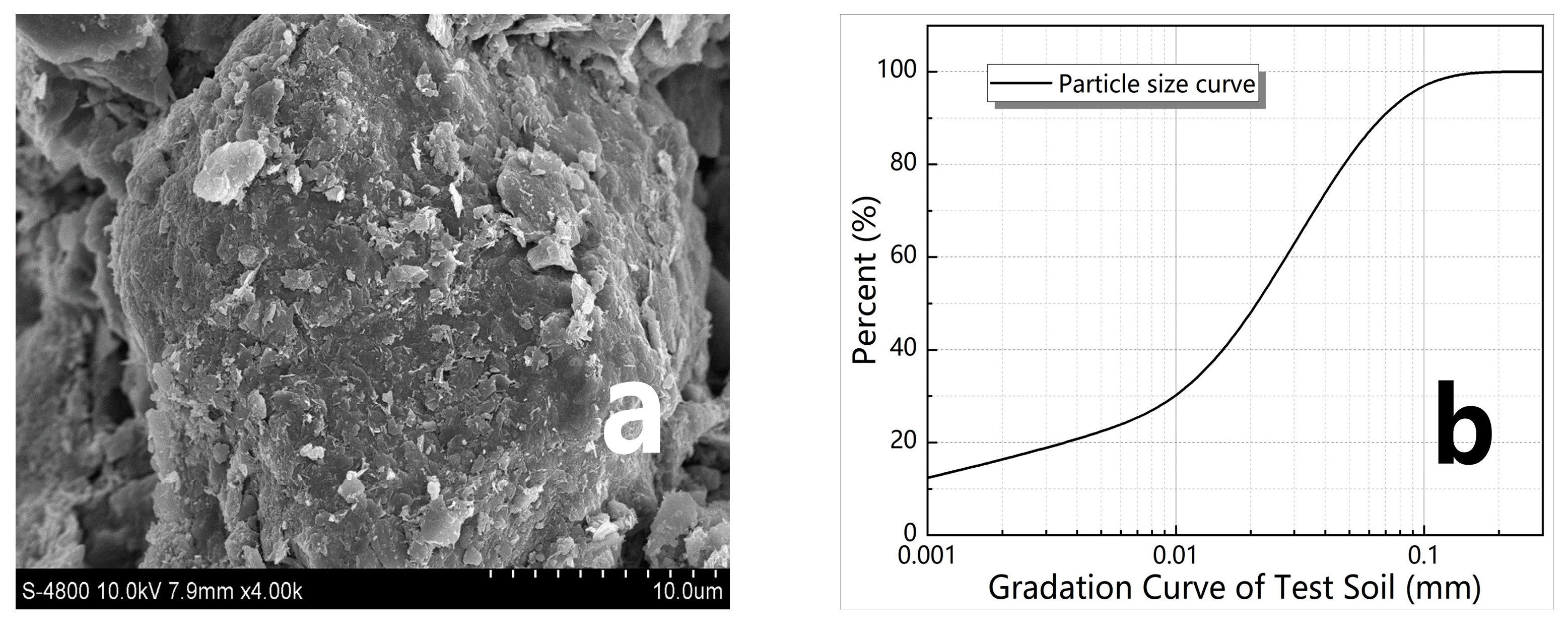
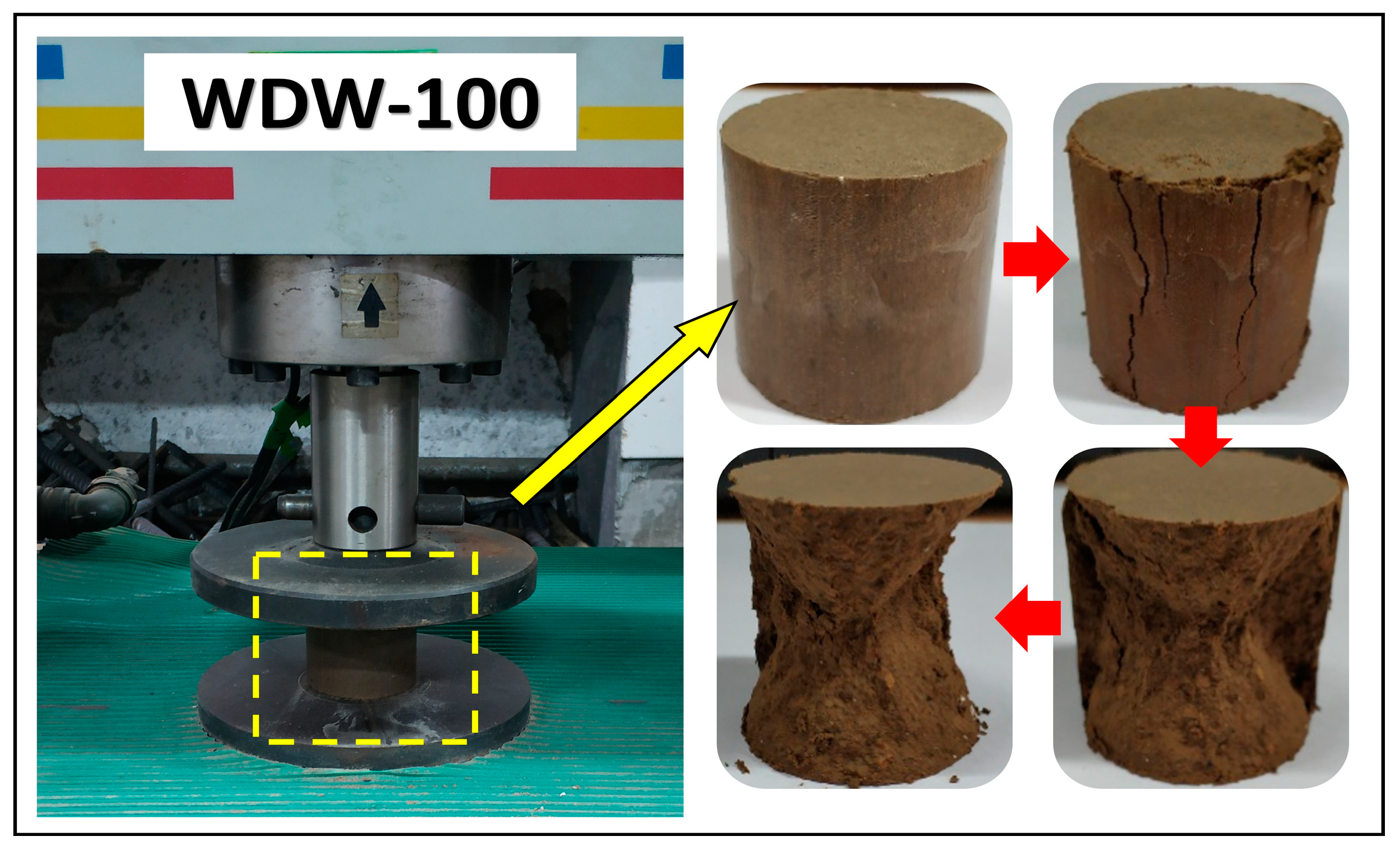
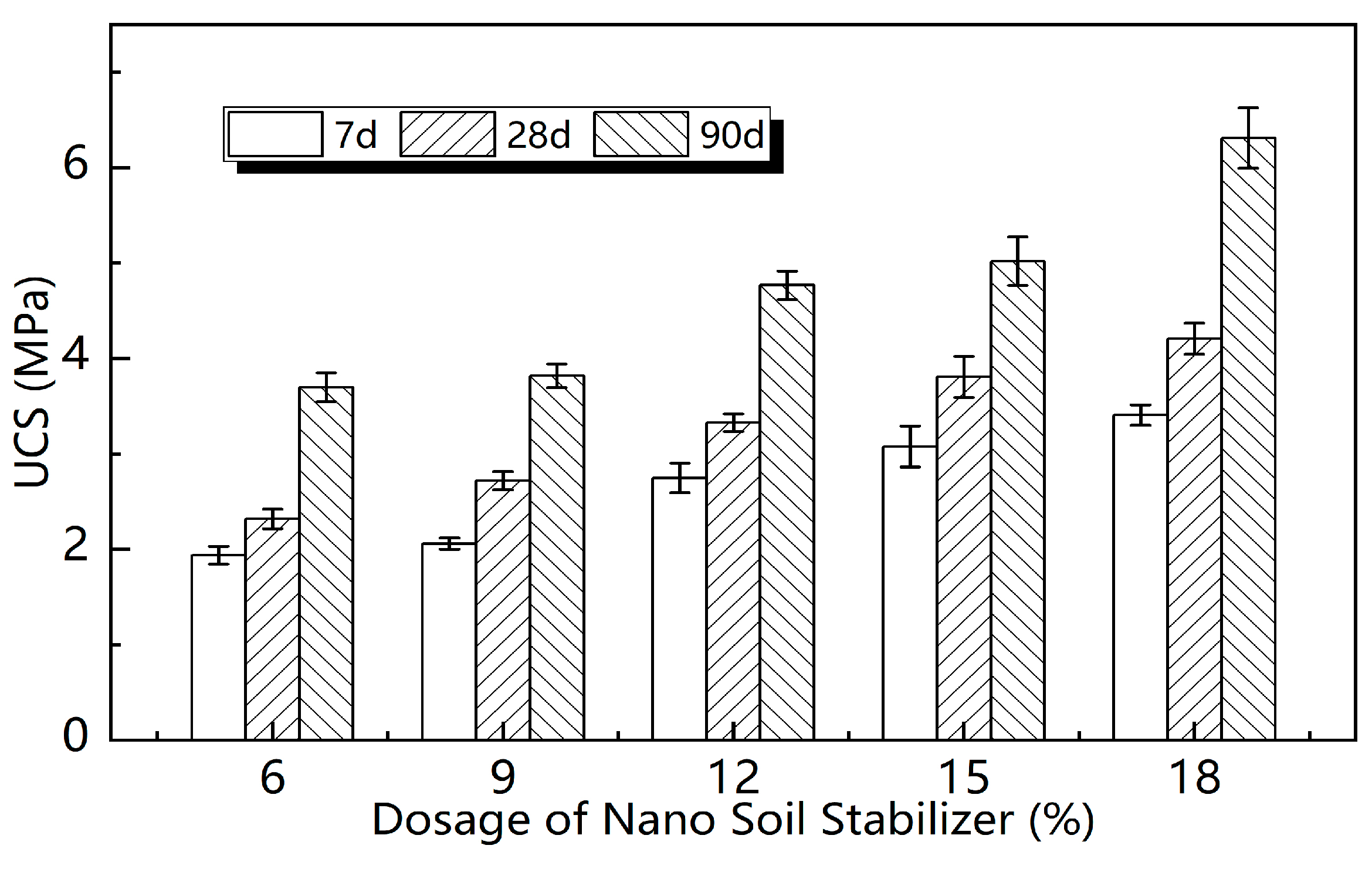

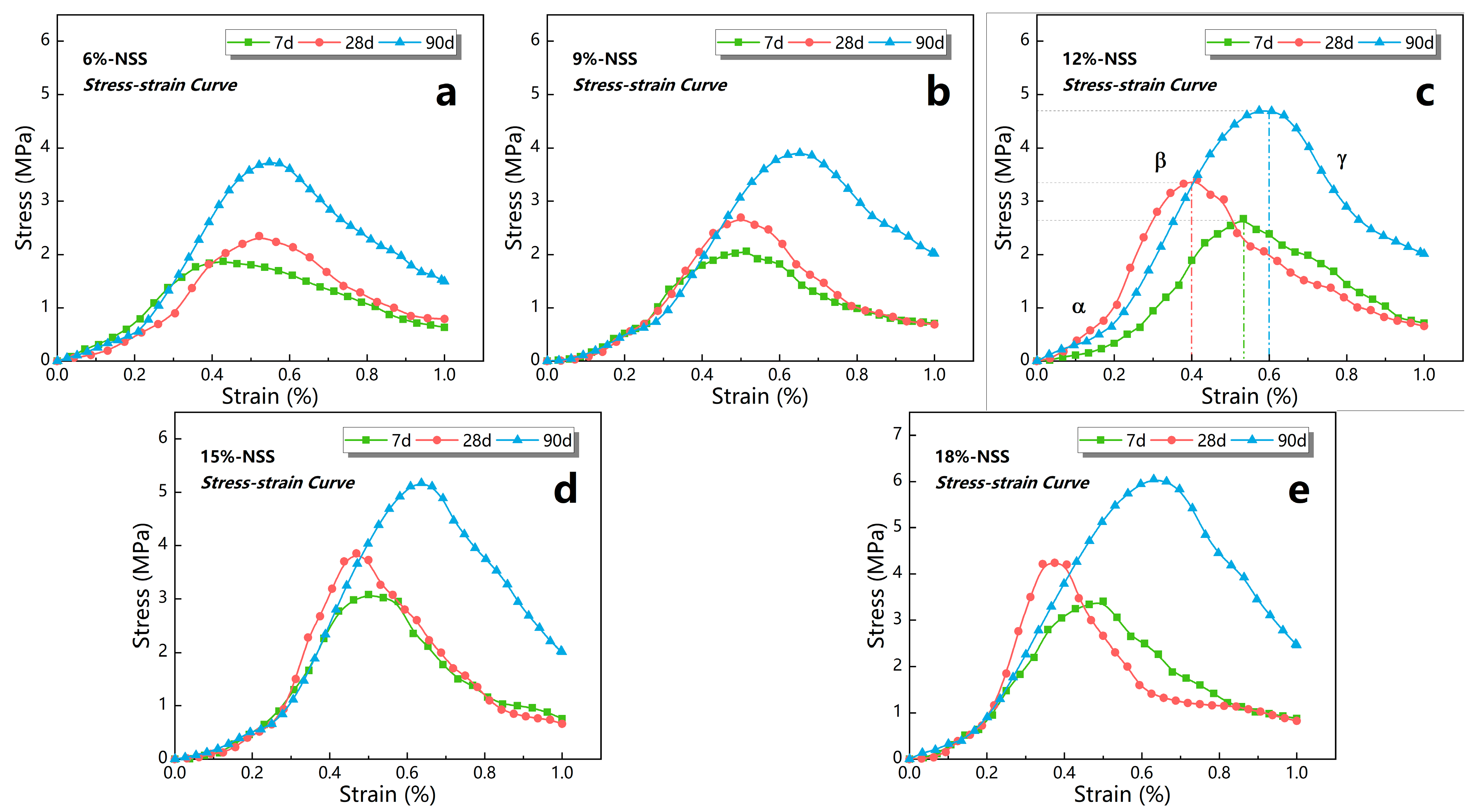
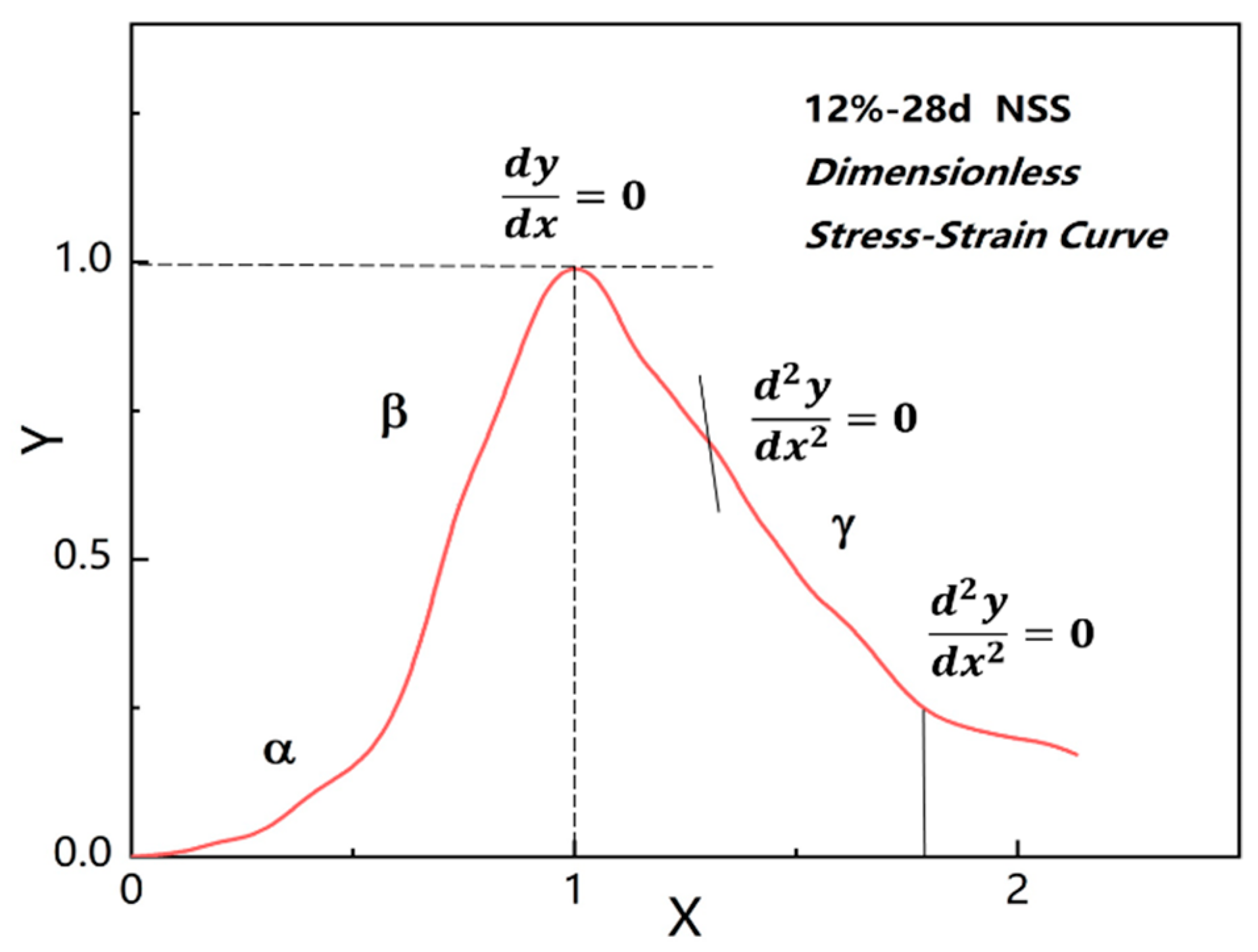

| Ingredients | Types | Content % |
|---|---|---|
| Nanoparticles | Nano SiO2 | 1~3 |
| Gelling Agent | Cement Clinker | 75~85 |
| Alkaline Catalyst | Fly Ash | 8~10 |
| Grinding Aid | Slag | 2~3 |
| Retarder | Gypsum | 3~5 |
| Surfactant | Active Agent | 1~2 |
| Test Groups | Dosage (%) | Curing Period (Days) | ||
|---|---|---|---|---|
| 7 | 28 | 90 | ||
| NSS | 6 | A1-1 | A1-2 | A1-3 |
| 9 | A2-1 | A2-2 | A2-3 | |
| 12 | A3-1 | A3-2 | A3-3 | |
| 15 | A4-1 | A4-2 | A4-3 | |
| 18 | A5-1 | A5-2 | A5-3 | |
| SS | 12 | A0-1 | A0-2 | A0-3 |
| CM | 12 | AA-1 | AA-2 | AA-3 |
| Dosage % | Period Days | Con-2010 | S-Logistic | |||
|---|---|---|---|---|---|---|
| 6 | 7 | −0.138 | 1.988 | 1.085 | 6.150 | 0.553 |
| 28 | −1.012 | 4.985 | 1.113 | 6.476 | 0.649 | |
| 90 | −0.980 | 4.138 | 1.097 | 6.913 | 0.632 | |
| 9 | 7 | −0.515 | 5.511 | 1.043 | 7.432 | 0.561 |
| 28 | −1.334 | 6.784 | 1.129 | 6.797 | 0.680 | |
| 90 | −1.071 | 5.626 | 1.104 | 7.111 | 0.641 | |
| 12 | 7 | −1.348 | 5.556 | 1.119 | 6.932 | 0.679 |
| 28 | −0.729 | 4.916 | 1.070 | 7.331 | 0.594 | |
| 90 | −0.776 | 4.856 | 1.071 | 6.905 | 0.602 | |
| 15 | 7 | −1.376 | 6.466 | 1.149 | 6.900 | 0.690 |
| 28 | −1.906 | 7.159 | 1.148 | 7.930 | 0.743 | |
| 90 | −1.297 | 7.209 | 1.092 | 7.407 | 0.659 | |
| 18 | 7 | −0.474 | 7.295 | 1.051 | 7.339 | 0.560 |
| 28 | −1.721 | 5.914 | 1.146 | 7.952 | 0.717 | |
| 90 | −0.567 | 6.173 | 1.047 | 6.894 | 0.572 | |
| Dosage % | Period Days | Adj. R2 | RCS | ||||
|---|---|---|---|---|---|---|---|
| Con-2010 | S-Logistic | Con-2010 | S-Logistic | ||||
| AS | DS | AS | AS | DS | AS | ||
| 6 | 7 | 0.9929 | 0.9673 | 0.9969 | 0.0010 | 0.0018 | 0.0005 |
| 28 | 0.9663 | 0.9953 | 0.9958 | 0.0047 | 0.0003 | 0.0007 | |
| 90 | 0.9784 | 0.9934 | 0.9992 | 0.0030 | 0.0003 | 0.0001 | |
| 9 | 7 | 0.9932 | 0.9742 | 0.9964 | 0.0010 | 0.0013 | 0.0006 |
| 28 | 0.9592 | 0.9952 | 0.9978 | 0.0057 | 0.0003 | 0.0004 | |
| 90 | 0.9762 | 0.9836 | 0.9984 | 0.0033 | 0.0005 | 0.0002 | |
| 12 | 7 | 0.9514 | 0.9756 | 0.9982 | 0.0065 | 0.0015 | 0.0003 |
| 28 | 0.9869 | 0.9777 | 0.9970 | 0.0020 | 0.0014 | 0.0006 | |
| 90 | 0.9885 | 0.9862 | 0.9996 | 0.0016 | 0.0007 | 0.0001 | |
| 15 | 7 | 0.9530 | 0.9901 | 0.9969 | 0.0067 | 0.0007 | 0.0005 |
| 28 | 0.8723 | 0.9902 | 0.9971 | 0.0170 | 0.0008 | 0.0004 | |
| 90 | 0.9636 | 0.9932 | 0.9993 | 0.0049 | 0.0003 | 0.0001 | |
| 18 | 7 | 0.9947 | 0.9676 | 0.9977 | 0.0008 | 0.0019 | 0.0004 |
| 28 | 0.9198 | 0.9591 | 0.9963 | 0.0119 | 0.0027 | 0.0007 | |
| 90 | 0.9962 | 0.9945 | 0.9991 | 0.0005 | 0.0003 | 0.0001 | |
Disclaimer/Publisher’s Note: The statements, opinions and data contained in all publications are solely those of the individual author(s) and contributor(s) and not of MDPI and/or the editor(s). MDPI and/or the editor(s) disclaim responsibility for any injury to people or property resulting from any ideas, methods, instructions or products referred to in the content. |
© 2023 by the authors. Licensee MDPI, Basel, Switzerland. This article is an open access article distributed under the terms and conditions of the Creative Commons Attribution (CC BY) license (https://creativecommons.org/licenses/by/4.0/).
Share and Cite
Zhang, X.; Gao, J.; Qiang, M.; Zhang, H.; Li, X.; Long, S.; Gao, Z.; Fan, H. Mechanical Characterization and Constitutive Modeling of Nano-Stabilized Soil under Uniaxial Compression. Materials 2023, 16, 1488. https://doi.org/10.3390/ma16041488
Zhang X, Gao J, Qiang M, Zhang H, Li X, Long S, Gao Z, Fan H. Mechanical Characterization and Constitutive Modeling of Nano-Stabilized Soil under Uniaxial Compression. Materials. 2023; 16(4):1488. https://doi.org/10.3390/ma16041488
Chicago/Turabian StyleZhang, Xingchen, Jianen Gao, Minmin Qiang, Haochen Zhang, Xinghua Li, Shaobo Long, Zhe Gao, and Henghui Fan. 2023. "Mechanical Characterization and Constitutive Modeling of Nano-Stabilized Soil under Uniaxial Compression" Materials 16, no. 4: 1488. https://doi.org/10.3390/ma16041488
APA StyleZhang, X., Gao, J., Qiang, M., Zhang, H., Li, X., Long, S., Gao, Z., & Fan, H. (2023). Mechanical Characterization and Constitutive Modeling of Nano-Stabilized Soil under Uniaxial Compression. Materials, 16(4), 1488. https://doi.org/10.3390/ma16041488






